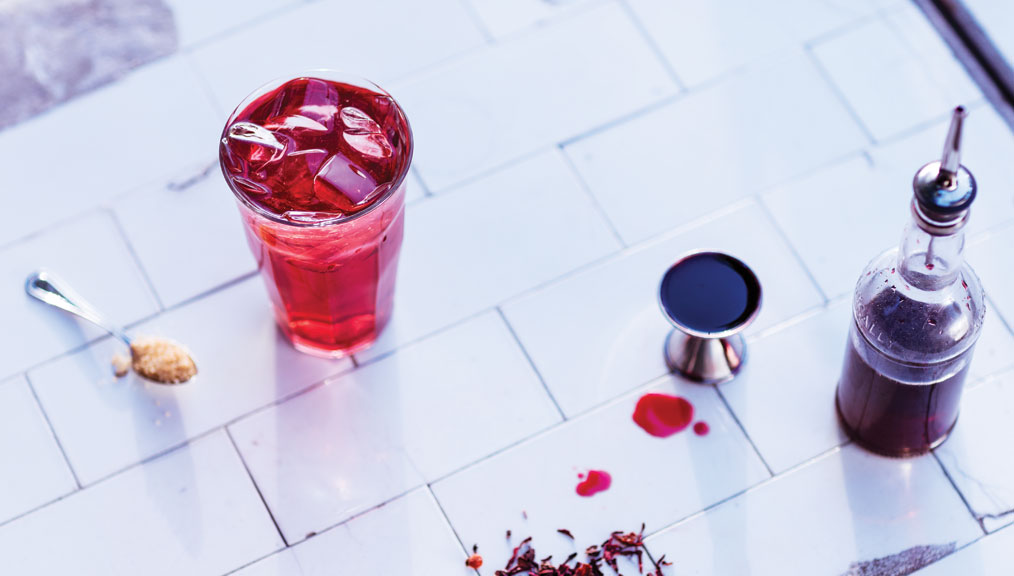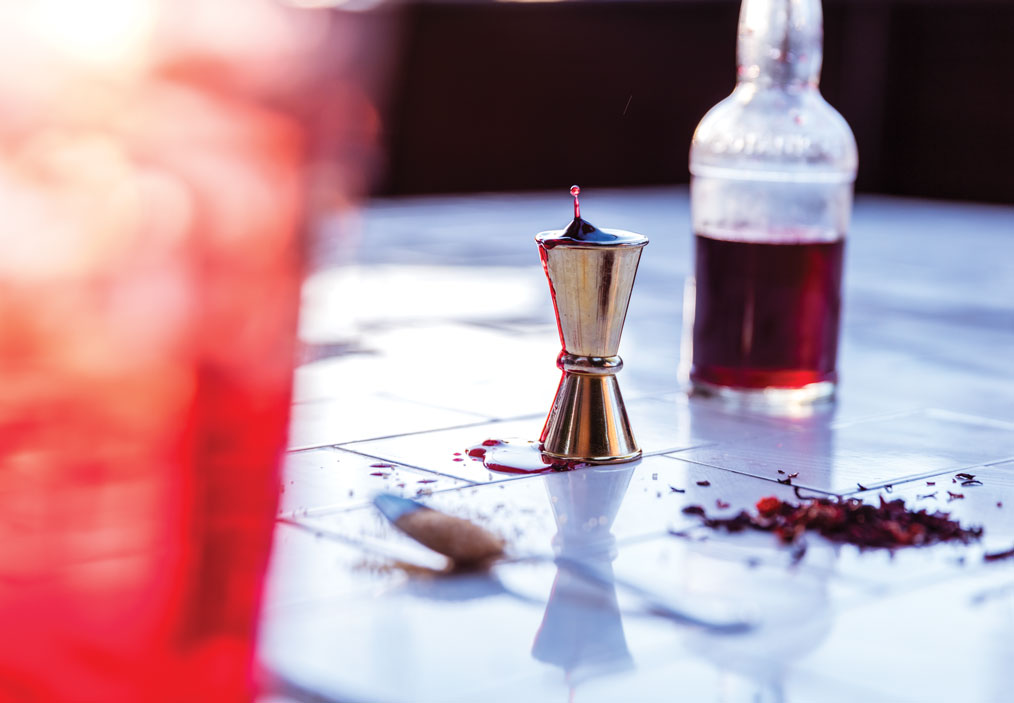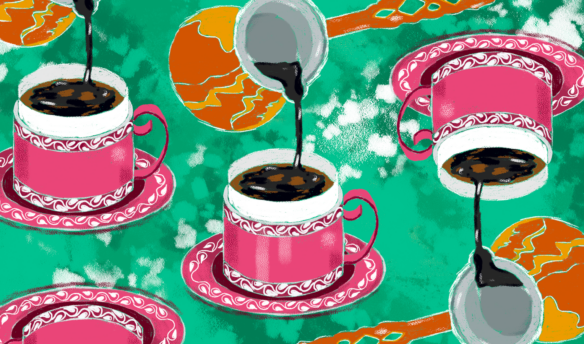[S]ome people don’t like coffee or tea. I don’t get it, but it’s true. Having a very focused menu comprising only coffee and tea—or even just coffee—may be desirable and cool, but it can be alienating for folks who would otherwise visit your café. Plus, sometimes one needs something more refreshing than iced coffee or iced tea. Sometimes one needs something light and fizzy—like soda. I’m talking about scratch-made drinks that you can easily make yourself, using ingredients that you probably already have lying around your home or café.
In order to illustrate my methods, I created, on the fly, a few brand-new sodas as examples. I gave myself a rule: I could only use ingredients that I already had on hand and that the average café might have as well. I could tell you how to make one of the Rose Establishment’s signature sodas called the Amethyst (a mixture of blue pea flower, gentian root, wild cherry bark, turbinado sugar, soda water, Scrappy’s Orleans bitters mist, and edible calendula petals), but you probably don’t have many of the ingredients. You can get started with as little as soda water, sugar, and a loose-leaf tea or tisane, like I did.
First, I made a syrup. I picked Art of Tea’s blend of rosehip and hibiscus because it has a potent flavor and a pleasant tartness. Unlike a traditional 1:1 simple syrup, I used a 1:2 sugar to water ratio. Otherwise, the drink would end up being unbearably sweet. I simmered 20 grams of the tisane in 500 grams water for ten minutes. I added 250 grams turbinado sugar and simmered for ten more minutes. I let it cool, strained it with a fine-mesh strainer, and bottled it. I mixed an ounce of rosehip and hibiscus syrup with ten ounces soda water, topped it with ice, and enjoyed an instant summertime soda.
You can use this same recipe with practically any ingredient as the base flavor, keeping your sodas very basic. With a couple more ingredients, though, you can create some unique and impressive flavors. SerendipiTea’s Remember Rosemary blend (rosemary, gunpowder green tea, orange peel, lemon myrtle) was begging to become a soda. I made a syrup using the same recipe as the rosehip and hibiscus and mixed it with soda water. It was good, but it didn’t pop—the green and herbal blend lacked the tartness inherent in the rosehip and hibiscus before it. Every summer at the Rose we can and preserve a bunch of local produce, and we use citric acid to adjust the pH. I had previously made a 50 percent solution with this powdered citric acid and I added ten drops of it to the rosemary soda. It instantly balanced out the flavors and upped the refreshment factor. It was still one step from perfection, so I added a couple dashes of my go-to flavor enhancer: bitters. Scrappy’s grapefruit bitters, to be exact.
We could stop here in terms of complexity, interchanging the base flavor and bitters ad infinitum. We would be ignoring one obvious on-hand ingredient, though: coffee. Coffee, namely espresso, has such intense and complex flavor, which can provide a savory element to more complicated sweet drinks. I had a crazy idea to recreate the flavor of cherry cola—using only ingredients that I already had. I got the idea from Jordon Strang, one of our baristas who created a coffee cola the year prior. His recipe used several herbal blends that we no longer carry, so I had to start from scratch.
I swiped 50 grams of dried tart cherries from our kitchen and chopped them up and tossed them in a saucepan, I added one split and scraped vanilla pod, 10 grams wild cherry bark from my weird ingredients kit, three star anise from my chai kit, and 500 grams water. I simmered it for ten minutes, added 400 grams turbinado sugar, and simmered it for ten more minutes. After cooling and straining, I had the barista pull me two espressos—60 grams total of Four Barrel’s Friendo Blendo. I mixed an ounce and a half of this syrup with two dashes of Workhorse Rye’s aromatic coffee bitters, ten drops citric acid, ten ounces soda water, and ice. I nearly wept. It tasted exactly like cherry cola.
This is something that you can easily do, and modify to your heart’s content. If you were to serve something with bitters and citric acid, you can add them to the syrup itself instead of adding them to each individual drink—you’ll have to figure out how much of each, since I didn’t get that far with the above examples. If you feel like squeezing fresh lemons every morning instead of using citric acid, go for it—our barista Austin Wright did this in a lemonade soda using Scrappy’s lavender bitters, Workhorse Rye aromatic coffee bitters, and the Remember Rosemary syrup. Whether you use four ingredients or twelve, whipping up a soda or two is a painless way to refresh and impress your guests—especially when you already have the tools right in front of you.
 Simpler Sodas
Simpler Sodas
Crafting a finely balanced concoction of flavors might not be how you’re able to spend an afternoon, but you can still create unique, interesting sodas for your customers. Sodas are a great chance to see what crazy flavors your favorite syrup
company has to offer.
Monin offers flavors like acai and even a basil concentrate that would make fantastic sodas. DaVinci has a peach chipotle that could be paired with a tea concentrate to great effect. 1883 has a roasted red pepper that would shock (in a good way) any soda lover. And Torani’s Signature line could stock a line of soda fountains.
If you’ve been intrigued by a syrup but avoided it because it didn’t pair with espresso, now’s your chance to bring it in.
If you’re wary of unleashing an unknown drink on your customers, every syrup company has a raft of tested recipes that are easy to produce in a café. Once you get your feet under you, you’ll be mixing and matching flavors and making something no one anywhere else offers.
Bringing tea to these sodas simply requires brewing concentrates of two-, three-, or more times the amount of leaf of a normal brew. Play with herbals and refreshing oolongs and greens for the best results.






 Simpler Sodas
Simpler Sodas









